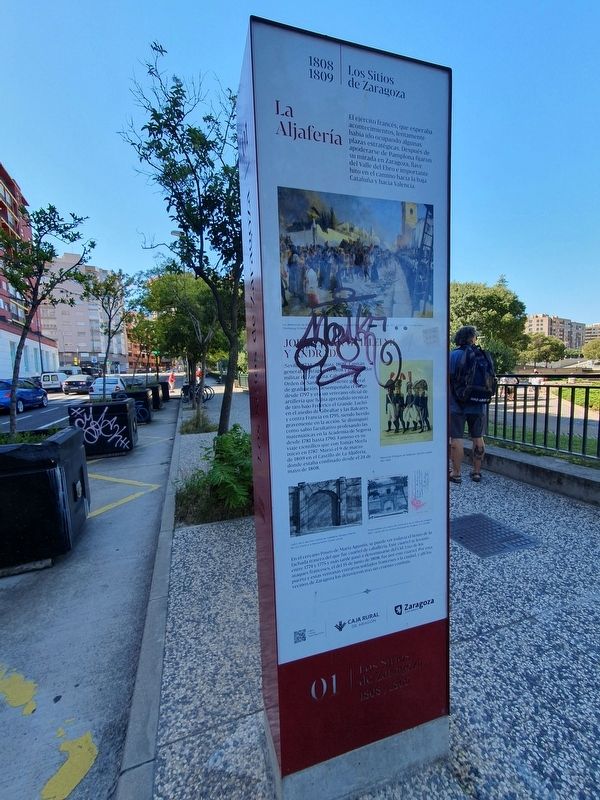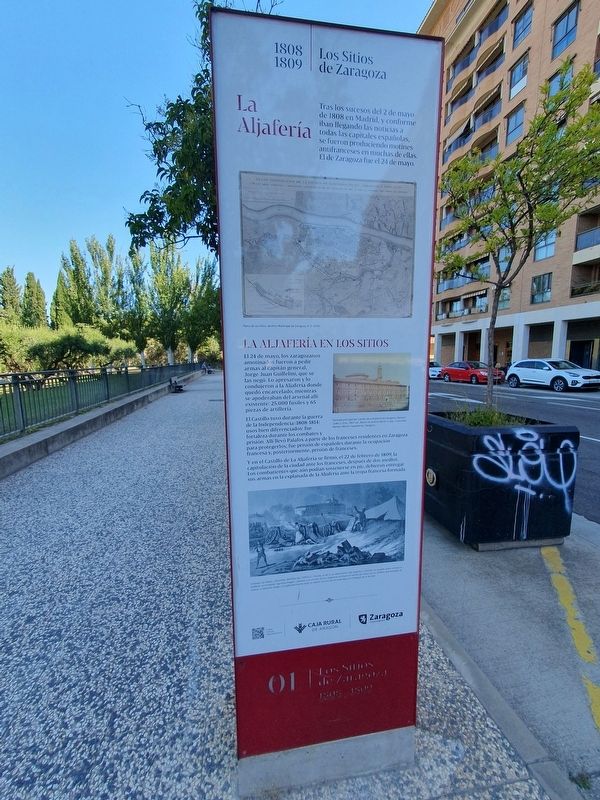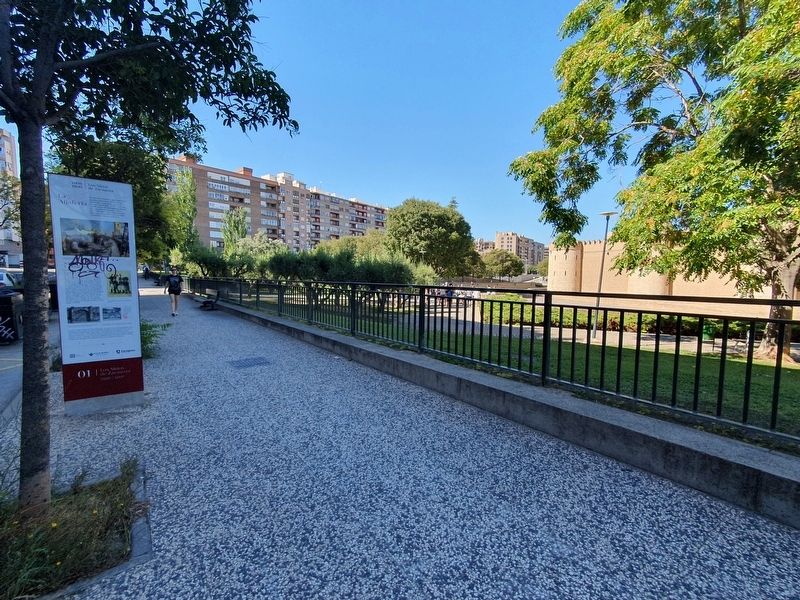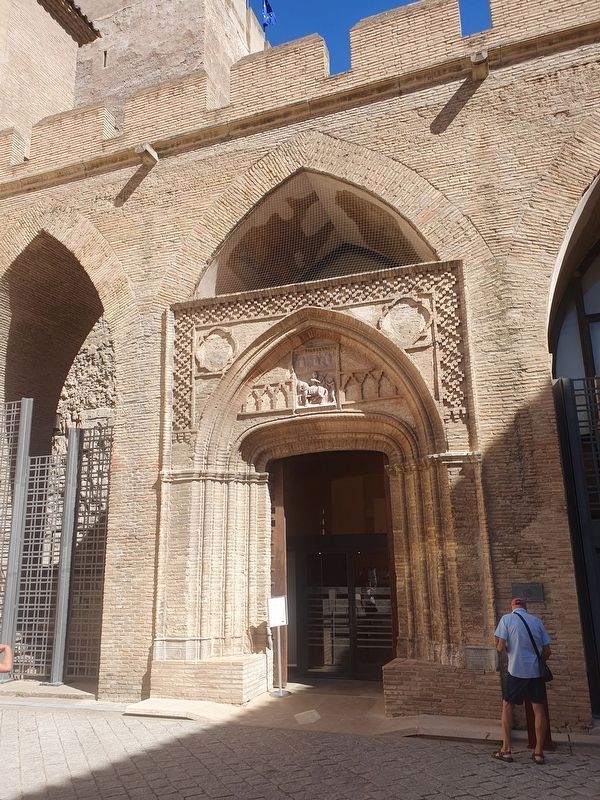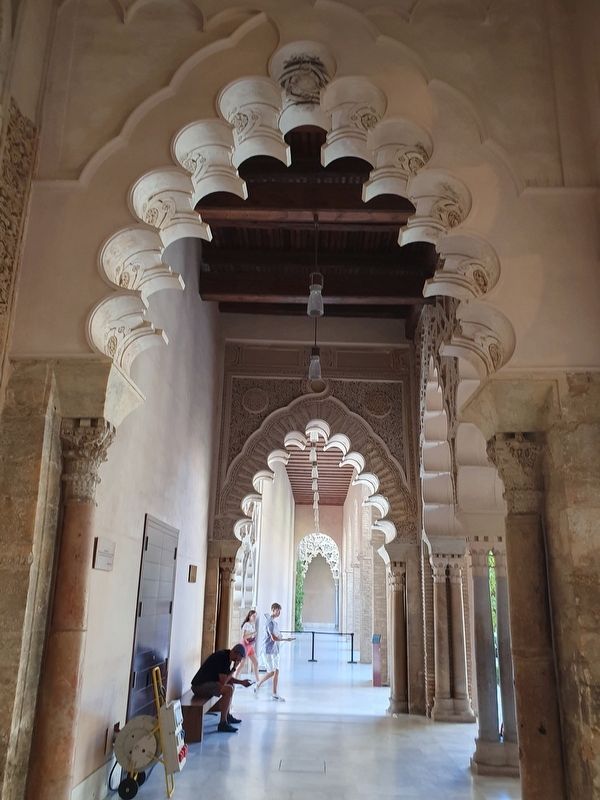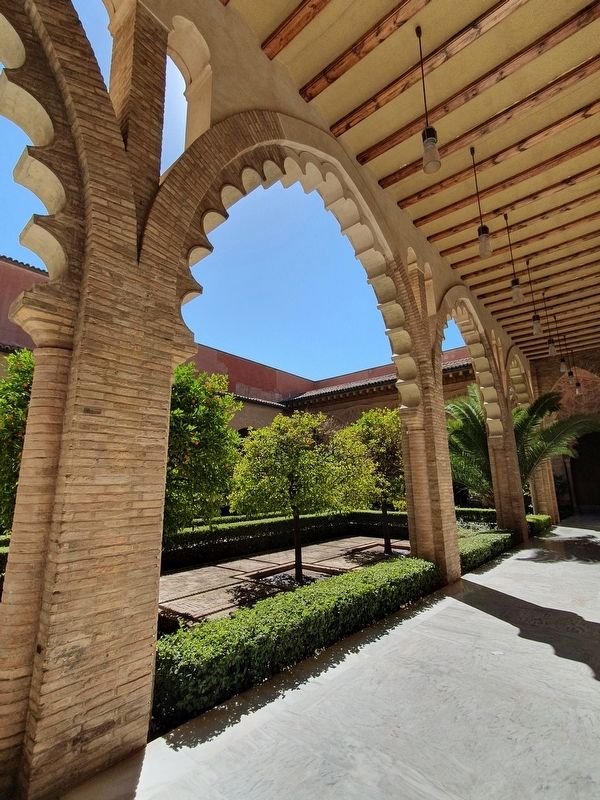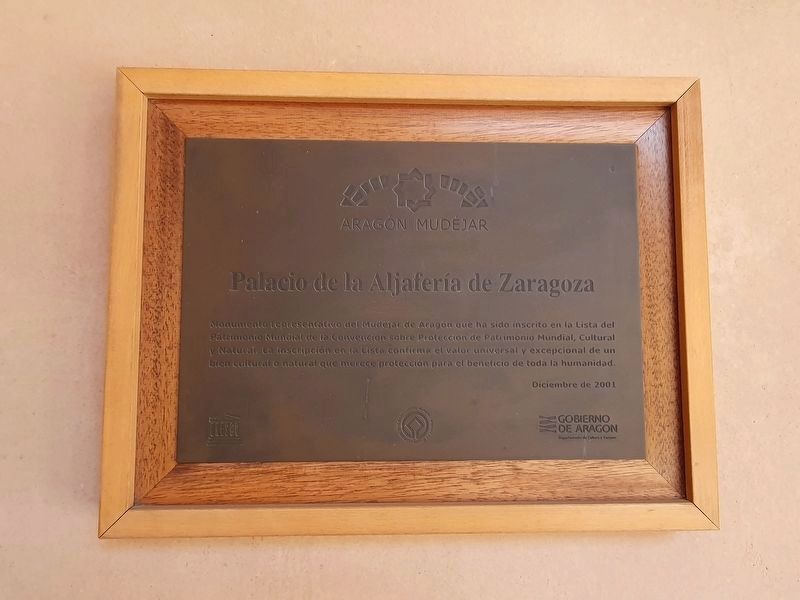La Almozara in Zaragoza, Aragón, Spain — Southwestern Europe (Iberian Peninsula)
La Aljafería
1808 · 1809 Los Sitios de Zaragoza
Tras los sucesos del 2 de mayo de 1808 en Madrid, y conforme iban llegando las noticias a todas las capitales españolas, se fueron produciendo motines antifranceses en muchas de ellas. El de Zaragoza fue el 24 de mayo.
La Aljafería en los Sitios
El 24 de mayo, los zaragozanos amotinados fueron a pedir armas al capitán general, Jorge Juan Guillelmi, que se las negó. Lo apresaron y lo condujeron a la Aljafería donde quedó encarcelado, mientras se apoderaban del arsenal allí existente: 25.000 fusiles y 65 piezas de artillería.
El Castillo tuvo durante la guerra de la Independencia (1808-1814) usos bien diferenciados: fue fortaleza durante los combates y prisión. Allí llevó Palafox a parte de los franceses residentes en Zaragoza para protegerlos; fue prisión de españoles durante la ocupación francesa y, posteriormente, prisión de franceses.
Y en el Castillo de La Aljafería se firmó, el 22 de febrero de 1809, la capitulación de la ciudad ante los franceses, después de dos asedios. Los combatientes que aún podían sostenerse en pie, debieron entregar sus armas en la explanada de la Aljafería ante la tropa francesa formada.
La Aljafería
El ejército francés, que esperaba acontecimientos, lentamente había ido ocupando algunas plazas estratégicas. Después de apoderarse de Pamplona fijaron su mirada en Zaragoza, llave del Valle del Ebro e importante hito en el camino hacia la baja Cataluña y hacia Valencia.
Jorge Juan Guillemi y Andrada
(Sevilla, 1734-Zaragoza, 1809). Capitán general de Aragón en 1808 y gobernador militar de Zaragoza. Caballero de la Orden de Santiago y teniente general de graduación. Desempeñaba el cargo desde 1797 y era un veterano oficial de artillería que había aprendido técnicas de tiro bajo Federico el Grande. Luchó en el asedio de Gibraltar y las Baleares y contra Francia en 1795, siendo herido gravemente en la acción. Se distinguió como sabio facultativo profesando las matemáticas en la Academia de Segovia desde 1781 hasta 1790. Famoso es su viaje científico que con Tomás Morla inició en 1787. Murió el 9 de marzo de 1809 en el Castillo de La Aljafería, donde estaba confinado desde el 24 de mayo de 1808.
En el cercano Paseo de María Agustín, se puede ver todavía el lienzo de la fachada trasera del que fue cuartel de caballería. Este cuartel se levantó entre 1774 y 1775 y más tarde pasó a denominarse del Cid. Uno de los ataques franceses, el del 15 de junio de 1808, fue por este cuartel. Por esta puerta y estas ventanas entraron soldados franceses a la ciudad, y allí los vecinos de Zaragoza los detuvieron tras un cruento combate.
Pie de dibujos
Plano de los Sitios. Archivo Municipal de Zaragoza, 4-2-0244.
Fachada principal del Castillo de la Aljafería de Zaragoza. Mariano Júdez y Ortiz, 1859-60. Álbum de Andrés Martín e Ipas. Colección Mariano Martín Casadelrrey, Zaragoza.
Grabado de Gálvez y Brambila: Bateria de Portillo. Donde, al ver a sus defensores caer muertos o heridos sin quedar quien sirviese la artillería, la intrépida “Agustina Aragón” saltando por encima de los cadáveres arrebató la mecha de manos de un artillero que acababa de expirar, y haciendo fuego con gallarda bizarria atajó el ímpetu furioso de los enemigos en el ataque del 4 de julio.
Los defensores de Zaragoza saliendo de la ciudad el día 21 de febrero de 1809. Maurice Orange, 1893. Musée d’Art Thomas Henry, Cherbourg-Octeville.
Manuscrito El Burgués de Hamburgo. Ejercito español 1807-1808.
Lienzo de lo que fue Cuartel de Caballería, llamado Cuartel del Cid, frente a la fábrica Averly. Estado actual.
Postal editada con motivo del Centenario de los Sitios de Zaragoza, 1908. Cuartel del Cid. Archivo Municipal de Zaragoza, 4-1_016308.
La Aljafería
Following the events on 2 May 1808 in Madrid and as news arrived from all the Spanish capital cities, anti-French riots arose in many of them. The one in Zaragoza took place on 23 May.
The Aljafería Palace in the Sieges
On 24 May, rebellious Zaragoza citizens requested weapons from Captain General, Jorge Juan Guillelmi, who refused them. They captured him and took him to the Aljafería Palace where he was imprisoned, while they seized the existing arsenal there: 25,000 rifles and 65 artillery pieces.
During the War of Independence (1808-1814), the Castle had well differentiated uses: it was a fortress during battles and a prison. Palafox took part of the French residents in Zaragoza there to protect them; it was a prison for Spaniards during the French occupation and subsequently, a prison for the French.
And after two sieges, the capitulation of the city to the French forces was signed in the Aljafería Castle on 22 February 1809. The combatants who could still stand had to surrender their weapons in the Aljafería esplanade in front of the French troop formation.
La Aljafería
As they awaited events, the French Army had slowly been occupying several strategic positions. After taking over Pamplona, they fixed their sights on Zaragoza, the key to the Ebro valley and a major milestone on the road towards lower Catalonia and Valencia.
Jorge Juan Guillemi y Andrada
(Seville, 5 January 1734). Captain General of Aragon in 1808 and Military Governor of Zaragoza. Knight of the Order of Santiago and Lieutenant-General upon graduation. He had served in that post since 1797 and was a veteran Artillery officer who had learned marksmanship techniques under Frederick the Great. He fought in the siege of Gibraltar and the Balearic Islands against France in 1795; and he was seriously wounded in action. He earned distinction as a wise professor and taught mathematics at the Academy of Segovia from 1781 to 1790. His famous scientific voyage with Tomás de Morla began in 1787. He died on 9 March 1809 in the Aljafería Castle where he had been confined since 24 May 1808.
In the nearby Promenade called Paseo de María Agustín, it is still possible to see the painting of the rear façade of the former Cavalry barracks. This barracks was built between 1774 and 1775 and was later named “El Cid” barracks. One of the French attacks took place at this barracks on 15 June 1808. The French soldiers invaded the city through that gate and those windows and the people of Zaragoza halted them there after a bloody combat.
Pie de dibujos
Plano de los Sitios. Archivo Municipal de Zaragoza, 4-2-0244.
Fachada principal del Castillo de la Aljafería de Zaragoza. Mariano Júdez y Ortiz, 1859-60. Álbum de Andrés Martín e Ipas. Colección Mariano Martín Casadelrrey, Zaragoza.
Engraving by Gálvez y Brambila. Portillo Artillery Battery. As she watched the defenders fall dead or wounded with no one to shoot the artillery, this is the spot where “Agustina de Aragón” jumped over the corpses to grab a fuse from the hands of a gunner who had just died. With uncanny bravery, she then halted the fierce momentum of the enemies in their attack on 4 July.
The defenders of Zaragoza departing from the city on 21 February 1809. Maurice Orange. 1893 Musée d’Art Thomas Henry Cherboug-Octeville.
Manuscrito El Burgués de Hamburgo. Ejercito español 1807-1808.
Canvas of the former Cavalry barracks, called “Cuartel del Cid”, in front of the Averly factory. Present state.
Postcard published to celebrate the centennial of the Sieges of Zaragoza, 1908. “Cid” Cavalry Barracks. Archivo Municipal de Zaragoza. 4-1_016308.
Erected by Ayuntamiento de Zaragoza. (Marker Number 01.)
Topics and series. This historical marker is listed in this topic list: Wars, Non-US. In addition, it is included in the UNESCO World Heritage Sites series list. A significant historical date for this entry is January 5, 1734.
Location. 41° 39.397′ N, 0° 53.728′ W. Marker is in Zaragoza, Aragón. It is in La Almozara. Marker is on Calle de los Diputados south of Calle de Santa Lucía, on the right when traveling south. Touch for map. Marker is at or near this postal address: C de los Diputados 21, Zaragoza, Aragón 50004, Spain. Touch for directions.
Other nearby markers. At least 8 other markers are within walking distance of this marker. Palacio de la Aljafería (within shouting distance of this marker); Iglesia de Nuestra Señora del Portillo (about 240 meters away, measured in a direct line); Plaza del Portillo (approx. 0.3 kilometers away); Plaza del Portillo Monumento a los Sitios de Zaragoza (approx. 0.3 kilometers away); Calle Ramón Pignatelli, 67 (approx. 0.7 kilometers away); Calle Ramón Pignatelli, 65 (approx. 0.7 kilometers away); Calle Ramón Pignatelli, 63 (approx. 0.7 kilometers away); Calle Ramón Pignatelli, 70 (approx. 0.7 kilometers away). Touch for a list and map of all markers in Zaragoza.
Also see . . . La Aljafería. The Ayuntamiento de Zaragoza maintains this website with Spanish, English and French versions of the markers in this series on the Sieges of Zaragoza in 1808 and 1809. (Submitted on November 24, 2023.)
Credits. This page was last revised on November 24, 2023. It was originally submitted on November 24, 2023, by J. Makali Bruton of Accra, Ghana. This page has been viewed 69 times since then and 25 times this year. Photos: 1, 2, 3, 4, 5, 6, 7. submitted on November 24, 2023, by J. Makali Bruton of Accra, Ghana.
